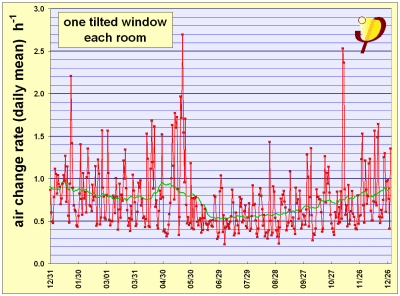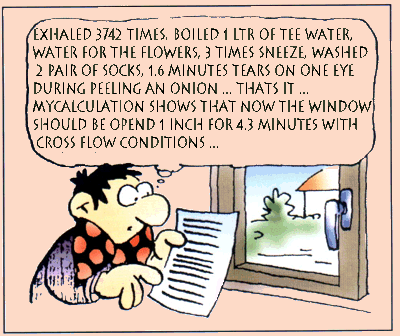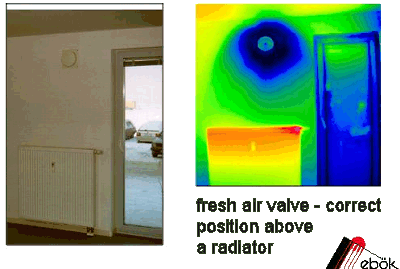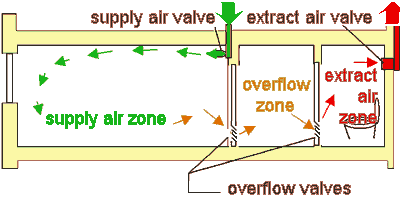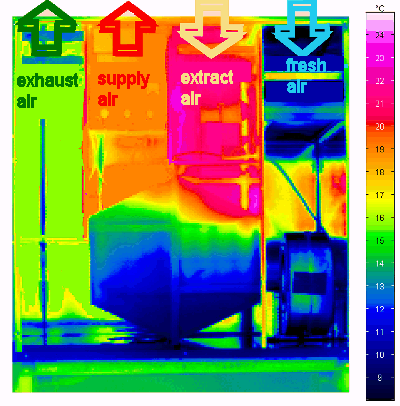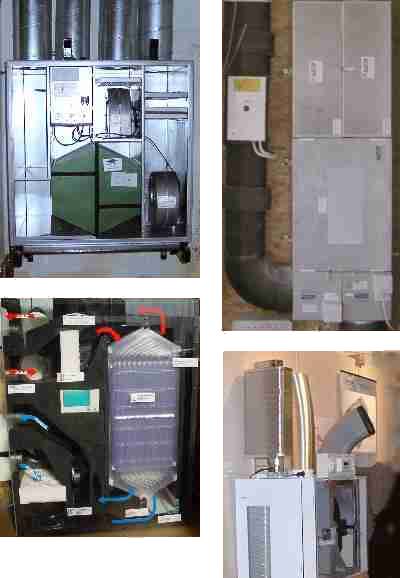| It is essential that
the ventilation system in a passive house can provide high quality
indoor air for the following reasons: A continuous exchange of sufficient
air volume has to be provided even in the cold season in any new
building – and that will only work using a mechanical system.
- Uncontrolled infiltration
through cracks in the building envelope is inadequate (see also
"airtightness“):
Wind and temperature driven stack ventilation fluctuates very
significantly in Central European climate (and that will hold
for almost any climate). A building, that is not completely airtight
might allow for sufficient infilration during calm weather but
will have unacceptable drafts during periods with high wind speeds
(see the first diagram left hand side). All new buildings constructed
in Germany after 1984 are built such that infiltration of air
will not be sufficient at all. This also holds for the refurbishment
of existing buildings, if new windows have been installed.
- It should also be
noted that if air can leak into a building, then warm and humid
air can also migrate out of a building which can lead to moisture
problems inside the construction.
- Without a mechanical
ventilation system in new building, one can only try to use the
strategy of opening the windows widely at regular intervals. To
achieve an air change rate of 0.33 ach, one would have to open
all the windows at least once every three hours for some 5 to
10 minutes at a time – even during the night (see the cartoon).
This would obviously be both impractical and unacceptable in most
dwellings. As a result, the indoor air quality would be poor coupled
with increased humidity. It is difficult for humans to easily
determine the quality of indoor air and we can not estimate the
amount of air that is exchanged by opening a window. Even for
an “expert” it is difficult to successfully and properly
ventilate a room simply by opening windows. If the ventilation
is inadequate, the indoor air quality will be unhealthy and there
will be a significant risk of condensation. If the ventilation
is too high, on the other hand, the air will be too dry and there
will be a high energy loss.
- The function of a
ventilation system is to supply fresh air in the right amount
into the living space. The simplest solution is an exhaust fan
ventilation system. It will extract the stale and humid air from
kitchens and bathrooms. Pulled by the small under-pressure caused
by the fan, fresh air will flow through inlet air valves into
the living spaces. These simple systems are nowadays standard
in France and in Sweden where there is experience for more than
50 years using exhaust fan ventilation systems. In Germany that
could be a satisfactory solution for new constructions just meeting
the requirements of the energy conservation ordinance and for
refurbishment of existing buildings. But these simple systems
are not suitable for Passive Houses because it is cold air, which
is supplied to the rooms and therefore the heat loss will be far
too high (see IR-photo at the left hand side). To maintain a high
level of comfort, a relatively high peak load will be required
with a radiator near the inlet valve. The resulting annual energy
consumption for heating will be at least double that of a truly
passive house.
- Systematic research
in dwellings has shown, that for a appropriate distribution of
fresh air to all rooms and an sufficient volumes of extract air
from the wet rooms a controlled supply and exhaust air system
is most suitable. Fresh air will be supplied to the living, working
and sleeping rooms. Each of these rooms will have a supply air
valve. Similarly in the exhaust fan ventilation system, the used
air will be extracted from the kitchen, bathrooms and other rooms
with high indoor air pollutants through extract valves.This will
result in cross flow ventilation in the dwelling: The fresh air
will at first enter the main living rooms (see section) from where
it will flow through the overflow zones into the wet rooms. The
wet rooms will have a quite high ventilation rate and therefore
it will not take a long time for towels to dry. The principle
of cross flow ventilation allows for an optimal utilisation of
the fresh air. It will at the beginning maintain an excellent
indoor air quality in the living rooms, then taking away stale
air in the overflow zones (e.g. from the wardrobe in the hall)
and last, but not least, dehumidify the air in the wet rooms.
- Supply- and exhaust
ventilation systems open the opportunity for heat recovery from
the exhaust air to the incoming fresh air. In dwellings in Central
Europe the ventilation heat loss with an appropriate air change
rate will be between 20 and 30 kWh/(m²a). Compared to all
other heat flows in an energy efficient house that is a very high
value, in fact more than the overall heat requirement in a typical
passive house. There are currently available heat exchangers that
achieve a 75 to 95% recovery rate for these heat losses. These
highly efficient recovery units have been developed especially
for the use in passive houses. This equipment has a distinct separation
between exhaust and fresh air, require only a small amount of
electricity to run and are extremely quiet. Using such an efficient
heat recovery, the remaining ventilation losses will be negligible;
between 2 and 7 kWh/(m²a) (this is a precondition for a passive
house). By the way the heat recovery will increase the temperature
of the supply air to a value quite near to the room air temperature.
The supply air thus will not be "cold" any longer. That
opens the opportunity to reduce the peak heating load and to reduce
the cost for heat distribution throughout the house.
- In a passive house
- and only in a passive house - there will be another advantage:
The opportunity, to heat the supply air rooms by heating the supply
air. Fresh air has to be supplied to living, study and sleeping
rooms anyway - therefore this air can be used for heat distribution,
too. But it is only fresh air (not recirculated air!), the mass
flow is limited (to avoid dry air conditions) and the temperature
is not allowed to exceed 55 °C. Therefore this type of fresh
air heating will only work for buildings with a very low heat
requirement - precisely the defining condition for a passive house.
This gives the opportunity to use quite smart and space saving
solutions for the building services, e.g. the ventilation compact
units.
Passive houses will always
use an integrated mechanical ventilation and often this is the central
unit for the whole building services. Only high quality ventilation
technology is suitable for passive houses. There are certain requirements
for central ventilation units defined by the Passive House Institute:
Not only should the efficiency of the heat exchanger be high, but
the consumptions of the fans should be low, the operational conditions
should clean and the unit should be very quite. At the exhibition
during the 10th Conference on passive houses units and components
for mechanical ventilation will be demonstrated.
(updated: 2006-09-23
author: Wolfgang Feist - thanks to Tomas O'Leary (mosart Ireland)
for proof reading the translation of the 1st edition
© Passive
House Institute; unchanged copy is permitted, please give reference
to this page)
|
